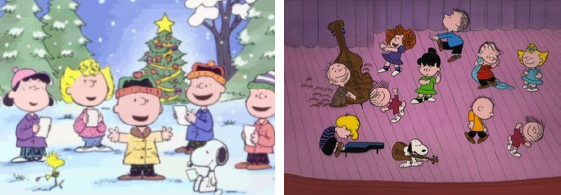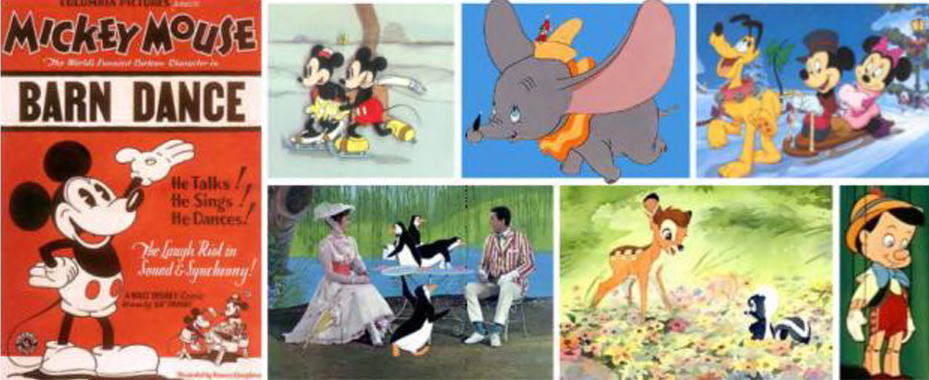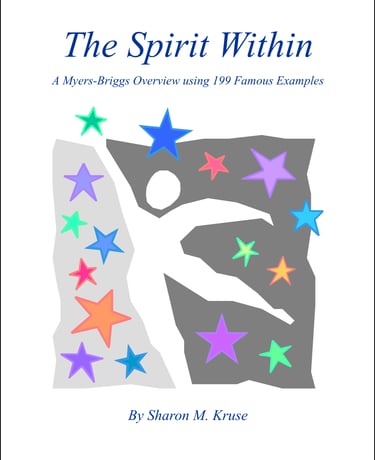Reality (S) / Imagination (N)
Sensing types notice the reality around them and see the present moment clearly, while intuitive types daydream about almost anything except the reality of the moment. “S” types have their feet planted firmly on the ground while “N” types often have their head in the clouds, imagining what might be possible.
Charles Schulz (ISTJ) / Walt Disney (INTJ)
Figure 15: Characters in Peanuts
Charles Schulz created the characters in the popular comic strip Peanuts. His art was Sensible: he drew cartoons with animals that acted (mostly) like animals. Unlike the art of Walt Disney, the animals in Peanuts did not talk, wear clothes, or drive.




Figure 16: Situations in Peanuts
Snoopy is a dog and acts like one. He belongs to a boy, eats dog food, and has a dog house. He doesn’t talk, he only thinks words. Woodstock, the little yellow bird, does not even think words, he just makes unintelligible noises. Snoopy had an active imagination, but he always imagined himself in real settings, whether it was playing hockey with the pros or being a flying ace in World War I.
We can also tell that Charles Schulz was an “S” type because he created characters from his own experience rather than from his imagination. The characters, locations and situations were fairly ordinary, created from memories of his personal life. When Schulz was a boy, he had a dog that later became the inspiration for Snoopy. Other members of the Peanuts gang also had real life counterparts. Charlie Brown was based largely on himself and named after a friend, and the little red-haired girl was modeled after a young woman who rejected his marriage proposal.
Almost every experience he had was reflected in his comic strips, from ice skating and playing hockey on frozen ponds to playing sandlot baseball, from his boyhood memories of Valentine’s Day and Halloween to raising his own family. Unlike most cartoonists, he drew every comic strip and did all the lettering himself. In the fifty years that Peanuts was published, Charles Schulz drew nearly 18,000 comic strips.
Walt Disney was an INTJ: his art was intuitive. He used his imagination to invent Mickey Mouse, an animal unlike any other because he could talk, sing, and dance. Mickey, Minnie, Donald, and Goofy wore clothes and did everything people could do.


Figure 17: Animals in Peanuts


Figure 18: The Imagination of Walt Disney
Disney’s full-length animated features were based on fantasy. The queen in Snow White and the Seven Dwarfs had a magic mirror that spoke to her. Dumbo was an elephant who could fly. Pinocchio was a wooden puppet that could talk and whose nose grew whenever he told a lie. How is that possible? He was made of wood!
The movie Mary Poppins was imaginative and inventive because it did something unique: it combined live actors with animation. The National Inventors Hall of Fame summed up Walt Disney’s contribution to the world when they said: “Seldom has an individual become so intrinsically linked to a concept as Walt Disney has with the concept of imagination.”
Unlike Charles Schulz, Walt Disney hired other artists to produce animations based on their ideas. This is another fundamental difference between the ISTJ and INTJ types. ISTJ Inspectors want to personally attend to every detail of their projects; INTJ Masterminds want to accomplish something monumental and are eager to harness the energy of others to achieve their goals.

